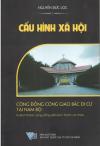
Nguyen Duc Loc
Ho Chi Minh City National University Press, 2014
Reviewed by Nguyen Quang Dung
This book offers an excellent ethnographic portrait and an insightful debate about the social structure, mobility and individual agency of two migrant religious communities adapting to a new land of resettlement. The author’s use of detailed ethnographic evidence in some chapters to back his theoretical discussion makes the book intellectually interesting. For those who want to have a thorough comprehension of the historical incident of 1954 that marked the melancholic exodus of Catholic people from northern to southern Vietnam, chapter 2 is a fascinating read. Nguyen Duc describes how these ‘migrants’ brought with them their religious and communal identity. The numerous anecdotes represent important fragments of history, culminating in a comprehensive appreciation of the development of these societies. First of all, they built churches, which became their safe refuge. Then they reproduced community structure on the basis of traditional patterns of northern communes, which were anchored to a common religious faith, creating a legacy of domicile social structure. Throughout the book, the author presents a thoughtful critique of other scholars’ concepts of social structure. The key subject of study is the ability of migrant Catholics to uphold core values of their social structure, community legacy and identity while also employing tactics to engage themselves with a new social space and place. Social actors had different strategies to deal with social relations in their pursuit of higher secular social status. Nguyen Duc highlights the specificity of social actors who are active in adapting to a larger society. Chapter 7 recounts an insightful debate on tactics of different religious individuals in different social contexts, and an analysis of the power relations they encounter in their daily life. That a couple performed some tricks to pass the priest’s test as a prerequisite for their wedding showcases these people’s ability to manage under unfavorable conditions to abide by religious rituals. Communist Party members in these communities experienced conflicts between religious practices and secular goals. Being a Communist and working for the government meant success and higher social status for some individuals. However, these religious communists had to switch between their roles as representatives of state power and as Catholics. In some contexts, these individuals choose to act as power practitioners to affirm their social status, which differentiated themselves from other community members. In other chapters, the author could have used more anecdotes about daily practices of identity and individuals’ tactics in order to enrich these subjects of study. Overall this is an insightful work in the discipline of anthropology – a case study worth reading of migrant Catholics in Vietnam.
